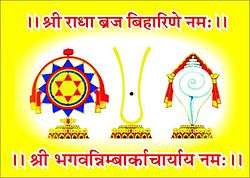Nimbarka Sampradaya
|
Shankha-Chakra-Urdhvapundra of the Nimbarka Sampradaya | |
| Founder | |
|---|---|
| Nimbarkacharya | |
| Regions with significant populations | |
| India & Nepal | |
| Languages | |
| Sanskrit , Hindi , Brajbhasha |
| Part of a series on |
| Vaishnavism |
|---|
 |
|
Sampradayas |
|
Philosophers–acharyas |
|
Related traditions |
|
|
The Nimbarka Sampradaya (IAST: Nimbārka Sampradāya, Sanskrit निम्बार्क सम्प्रदाय), also known as the Hamsa Sampradāya, Kumāra Sampradāya, Catuḥ Sana Sampradāya and Sanakādi Sampradāya, is one of the four authorised Vaiṣṇava Sampradāyas.
The Origins - Śrī Hansa Bhagavān

Śrī Nimbārka Sampradāya traditionally traces it origin to the four Kumaras, and aims the worship of Śrī Kṛṣṇa.
The Four Kumāras

The Four Kumaras namely: Sanaka, Sanandana, Sanātana, and Sanat Kumāra are traditionally the four mind-born sons of Lord Brahmā. They are renowned yogis, who requested their father the boon of remaining perpetually five years old. They were created by their father in order to advance creation, however, they chose to undertake lifelong vows of celibacy (brahmacarya).[1] Śrī Sanat Kumāra Samhitā is a famous treatise on the worship of Śrī Rādhā Kṛṣṇa authored by the brothers, and they have also produced the Śrī Sanat Kumāra Tantra, part of Pancarātra literature.[2] It is due to the tradition coming into contact with the Four Kumāras that it came to be known as the Sanakādi Sampradāya or the Kumāra Sampradāya.
Nārada Muni
The next recipient of the Śrī Gopāla mantra is Śrī Nārada Muni as indicated in the above sanskrit verse (see note 8). In the creation of this universe according to Paurāṇika literature, Śrī Nārada Muni is the younger brother of the Four Kumāras and son of Brahmā. He also rejected his father’s orders of increasing the population, and chose devotion to the Lord. He was thus present before all of the demigods, along with his elder brothers. He was blessed with the ability to travel to any part of creation according to tradition and he took initiation from his older brothers and their discussions as guru and disciple are recorded in the Upaniṣads with a famous conversation in the Chāndogya Upaniṣad; also with their discourses in the Śrī Nārada Purāṇa and the Pañcarātra literature. He is found in most of the religious scriptures always passing on knowledge of an event or teaching the path of Bhakti to all. He was the inspiration for the writing of the greatest Purāṇa – the Bhagavata Purana.
Nārada Muni and Nimbarka
Nārada Muni is recorded as main teacher in all four of the Vaiṣṇava Sampradāyas. But according to tradition at around 5100 years ago, he passed by Nimbagrāma near Govardhana in Vraja, and being pleased with the devotions of Śrī Nimbārkācārya, Śrī Nārada Muni initiated him into the sacred 18-syllabled Śrī GopālaMantra and introduced him to the philosophy of the Yugala upāsana – the devotional worship of the divine couple Śrī Rādhā Kṛṣṇa in accordance with the teachings of the Four Kumāras understanding of the Vedas. This was the first time that Śrī Rādhā Kṛṣṇa were worshipped together by anyone on earth other than the Gopis of Vṛndāvana. Śrī Nārada Muni then taught him the essence of devotion in the Śrī Nārada Bhakti Sūtras. Śrī Nimbārkācārya already knew the Vedas, Upaniṣads and the rest of the scriptures, but perfection was found in the teachings of Śrī Nārada Muni.[3]
Guru Parampara
- Sri Nimbarkacarya
- Sri Srinivasacarya
- Sri Dvadasacaryas
- Sri Astadasabhattacaryas
- Sri Harivyasadevacarya
- Sri Svabhuramadevacarya
- Sri Parasuramadevacarya
- Sri sri ji maharaj
- Sri Sri 108 Ramdas Kathiababaji Maharaj
- Sri Sri 108 Santadas Kathiababaji Maharaj
- Sri Sri 108 Dhananjaydas Kathiababaji Maharaj
- Sri Sri 108 Rashbeharidas Kathiababaji Maharaj (Present)
References
- ↑ "Bhaktivedanta VedaBase: Srimad Bhagavatam 3.12". Vedabase.net. Retrieved 22 December 2012.
- ↑ Sri Sarvesvara,Sri Nimbarkacarya Aur Unka Sampraday, Akhila Bharatiya Nimbarkacarya Pitha, Salemabad, Rajasthan, India, 1972
- ↑ Guy L. Beck (2005). "Krishna as Loving Husband of God". Alternative Krishnas: Regional and Vernacular Variations on a Hindu Deity. SUNY Press. ISBN 978-0-7914-6415-1. Retrieved 2008-04-12.
See also
External links
- http://www.shrijagatgurunimbarkacharyapeeth.org
- http://internationalnimbarkasociety.org
- http://www.golokdham.org
- http://www.sriradhabhakti.org
- http://www.nimbark.org
- http://www.kathiababa.in/nimbarka
- http://www.ramtekri.com
